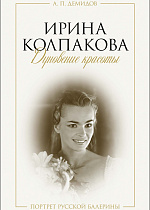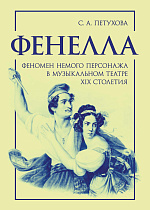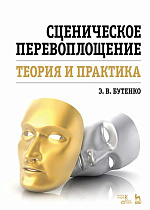История русского и зарубежного театра - все книги по дисциплине. Издательство Лань
Сохранить список:
Excel
Excel
Закрыть
Выгрузка списка книг доступна только авторизованным пользователям. Авторизоваться
Впервые публикуемая рукопись балетного критика Александра Павловича Демидова (1944–1990) сравнительно недавно обнаружилась в его архиве и посвящена творчеству выдающейся русской балерины Ирины Александровны Колпаковой. Ее творческий путь занял 1950–80-е гг. и протекал на сцене Кировского, ныне Мариинского театра. Сценический репертуар включил в себя сочинения М. Петипа, Ж. Коралли и Ж. Перро, М. Фокина, Ю. Григоровича, И. Бельского, Л. Якобсона, др. Автор застал расцвет ее сценической карьеры и запечатлел формирование стиля и исключительной артистической индивидуальности. Он анализирует послужной лист балерины не линейно, а с точки зрения высших совпадений ее духовной природы с хореографическим замыслом. И на основании этого выводит собственную концепцию, определяя место и роль Ирины Колпаковой в истории русского балета ХХ в.
Книга привлечет внимание балетоведов и театроведов и также будет интересна всем, в ком жива мысль о судьбах русского балета. Издание иллюстрировано новыми фотографиями.
The сurrent edition is the first publication of the manuscript by the ballet critic Alexander Pavlovich Demidov (1944–1990), which was recently discovered in his archive. It is devoted to the work of the outstanding Russian ballerina Irina Alexandrovna Kolpakova. Her career took place between the 1950s and the 1980s on the stage of the Kirov (now the Mariinsky) Theatre. Her stage repertoire included pieces by M. Petipa, J. Coralli and J. Perrot, M. Fokine, Y. Grigorovich and others. The author witnessed the heyday of her stage career and captured the formation of her style and exceptional artistic individuality. He analyzes the ballerina’s roles list not linearly but from the point of view of the highest concordance between her spiritual nature and the choreographic concept. Following these foundations, he makes his own concept, defining Irina Kolpakova’s place and role in the Russian ballet history of the 20th century.
The book will attract the attention of ballet and theatre experts and will also be of interest to anyone who is curious about the fate of Russian ballet. The edition is newly illustrated.
Книга привлечет внимание балетоведов и театроведов и также будет интересна всем, в ком жива мысль о судьбах русского балета. Издание иллюстрировано новыми фотографиями.
The сurrent edition is the first publication of the manuscript by the ballet critic Alexander Pavlovich Demidov (1944–1990), which was recently discovered in his archive. It is devoted to the work of the outstanding Russian ballerina Irina Alexandrovna Kolpakova. Her career took place between the 1950s and the 1980s on the stage of the Kirov (now the Mariinsky) Theatre. Her stage repertoire included pieces by M. Petipa, J. Coralli and J. Perrot, M. Fokine, Y. Grigorovich and others. The author witnessed the heyday of her stage career and captured the formation of her style and exceptional artistic individuality. He analyzes the ballerina’s roles list not linearly but from the point of view of the highest concordance between her spiritual nature and the choreographic concept. Following these foundations, he makes his own concept, defining Irina Kolpakova’s place and role in the Russian ballet history of the 20th century.
The book will attract the attention of ballet and theatre experts and will also be of interest to anyone who is curious about the fate of Russian ballet. The edition is newly illustrated.
Настоящая книга является первой попыткой рассмотрения феномена немого персонажа в оперном театре романтического XIX века. Главное место в исследовании занимает образ Фенеллы — титульной роли в опере Даниэля Обера и Эжена Скриба «Немая из Портичи» (1828), созданной для пантомимной солистки. Некогда это сочинение имело фантастическую популярность, а безмолвная партия становилась предметом конкуренции артисток разного амплуа: балерин и мимисток, драматических актрис и певиц. История постановок оперы на Западе и в России базируется на подробностях биографий этих исполнительниц, их взаимоотношений, пристрастий и интерпретаций.
Книга снабжена иллюстрациями и развёрнутыми приложениями, помогающими ориентироваться в театральном мире ушедших времён. Издание предназначено для специалистов театра и музыки, а также для всех, кто любит балетное искусство.
The current book is the first attempt to study the phenomenon of a mute character in the romantic 19th century opera theatre. The main place in the study belongs to the Fenella image, the title role in “La Muette de Portici” (“The Mute Girl of Portici”, 1828), the opera by Daniel Auber and Eugène Scribe, created for a solo pantomime performer. The piece used to be incredibly popular, and the mute part became the subject of competition between artists of a different type: ballet dancers and mime artists, drama actresses and singers. The history of the opera’s productions in the West and in Russia is based on these performers’ biographical moments, their relationships, sympathies and interpretations.
The book is illustrated and provided with detailed appendices, aimed to help readers understand the theatrical world of bygone times. The edition is intended for theatre and music experts, as well as for all music theatre lovers.
Книга снабжена иллюстрациями и развёрнутыми приложениями, помогающими ориентироваться в театральном мире ушедших времён. Издание предназначено для специалистов театра и музыки, а также для всех, кто любит балетное искусство.
The current book is the first attempt to study the phenomenon of a mute character in the romantic 19th century opera theatre. The main place in the study belongs to the Fenella image, the title role in “La Muette de Portici” (“The Mute Girl of Portici”, 1828), the opera by Daniel Auber and Eugène Scribe, created for a solo pantomime performer. The piece used to be incredibly popular, and the mute part became the subject of competition between artists of a different type: ballet dancers and mime artists, drama actresses and singers. The history of the opera’s productions in the West and in Russia is based on these performers’ biographical moments, their relationships, sympathies and interpretations.
The book is illustrated and provided with detailed appendices, aimed to help readers understand the theatrical world of bygone times. The edition is intended for theatre and music experts, as well as for all music theatre lovers.
В настоящее издание, помимо исследования доктора искусствоведения, профессора В. И. Максимова о театре и драматургии французского и русского символизма, включены пьесы Мориса Метерлинка в переводе Константина Бальмонта, пьесы Поля Верлена и других символистов, знаменитая трилогия о Папаше Убю Альфреда Жарри. Среди теоретических статей и материалов литераторов и театральных деятелей особо выделяются главы из четырехтомных мемуаров одного из самых значительных французских режиссеров первой половины ХХ века О. М. Люнье-По "Парад". Книга представляет несомненный интерес для литературоведов, театроведов, историков искусства, театральных практиков, почитателей французской культуры.
In addition to the study on the theatre and dramaturgy of French and Russian symbolism written by the doctor of art history, professor V.I. Maksimov, the current edition includes the plays by Maurice Maeterlinck translated by Konstantin Balmont, the plays by Paul Verlaine and other symbolists, the famous trilogy about Père Ubu by Alfred Jarry. Among the theoretical articles and materials of writers and theatre figures, the chapters from the “La Parade” (“The Parade”) stand out, the four-volume memoirs by A. M. Lugné-Poё, one of the most significant French directors of the first half of the 20th century. The book is of unquestionable interest for literary critics, theatre and art historians, theatre practitioners, and admirers of French culture.
In addition to the study on the theatre and dramaturgy of French and Russian symbolism written by the doctor of art history, professor V.I. Maksimov, the current edition includes the plays by Maurice Maeterlinck translated by Konstantin Balmont, the plays by Paul Verlaine and other symbolists, the famous trilogy about Père Ubu by Alfred Jarry. Among the theoretical articles and materials of writers and theatre figures, the chapters from the “La Parade” (“The Parade”) stand out, the four-volume memoirs by A. M. Lugné-Poё, one of the most significant French directors of the first half of the 20th century. The book is of unquestionable interest for literary critics, theatre and art historians, theatre practitioners, and admirers of French culture.
В основу книги положены результаты осмысления многолетнего режиссерского опыта автора. В книге рассматриваются психологические аспекты основ актерского творчества: воображения, действия, эмоций и чувств, игры и подражания, а главное – феномен актерского перевоплощения. В своей имитационной теории сценического перевоплощения автор опирается на «Парадокс об актере» Дени Дидро, на психологические исследования Л.С. Выготского, А.В. Запорожца, Д.Б. Эльконина, С.Л. Рубинштейна и др., опыт Евгения Вахтангова, Михаила Чехова, Соломона Михоэлса, пытается критически осмыслить научное обоснование «системы» Станиславского. Эта книга представляет интерес для актеров, режиссеров, театроведов, психологов и культурологов.





